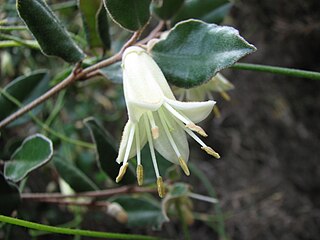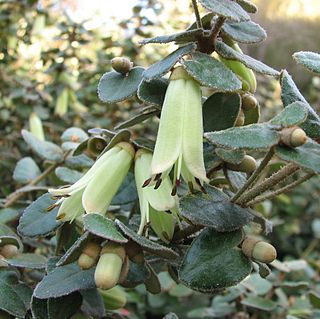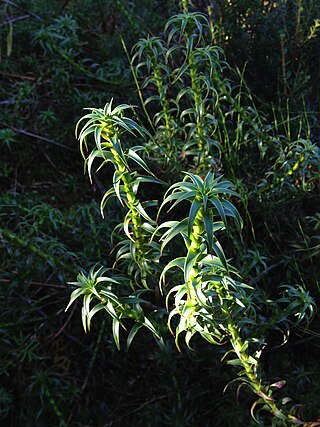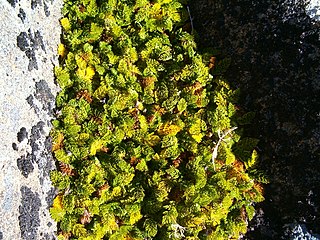
Ambuchanania leucobryoides is the only species in the monotypic genus Ambuchanania. It is a Sphagnum-like moss endemic to Tasmania. Originally described as a species of Sphagnum, it is now a separate genus named after the original collector Alex M. Buchanan, (b.1944) an Australian botanist from the Tasmanian Herbarium in Hobart,. A. leucobryoides differs from the family Sphagnaceae in having elongate antheridia. It is entirely restricted to south-west Tasmania's Wilderness World Heritage Area where it occurs on white Precambrian quartzitic sand deposited by alluvial flows, and on margins of buttongrass sedge land. Species most commonly found in association with A. leucobryoides include: Leptocarpus tenax, Chordifex hookeri, and Actinotus suffocatus. Currently, A. leucobryoides is listed as rare under the Tasmanian Threatened Species Protection Act 1995.

Correa backhouseana is a species of rounded shrub that is endemic to coastal and near-coastal areas of southern Australia. It has elliptical to egg-shaped or round leaves that are densely hairy on the lower surface, and cylindrical to funnel-shaped, cream-coloured to pale green or red and yellow flowers.

Eucalyptus vernicosa, commonly known as varnished gum, is a species of shrub or a mallee that is endemic to mountainous areas of Tasmania. It has smooth greyish bark, crowded, egg-shaped to elliptical or round leaves, flower buds singly or in groups of three in leaf axils, white flowers and hemispherical or bell-shaped fruit.

Phyllachne colensoi, the yellow cushionplant, is a species of cushion plant in the Stylidiaceae family. It is native to both New Zealand and Tasmania, with colonisation of the latter being a somewhat recent dispersal. Phyllachne colensoi is frequently the dominant vegetation in upland bog habitats and is found throughout high mountain areas in New Zealand, but is only recorded from 12 sites in Tasmania in the west and south-west of the island.

Gymnoschoenus sphaerocephalus, commonly known as buttongrass, is a species of tussock-forming sedge from southeastern Australia. It forms part of a unique habitat in Tasmania.

Gahnia grandis is a tussock-forming perennial plant found in southeastern mainland Australia and Tasmania.

Azorella macquariensis, also known as Macquarie azorella or Macquarie cushions, is a species of cushion plant endemic to Australia’s subantarctic Macquarie Island. It was referred to the more widely distributed Azorella selago until 1989, when it was described as a separate species.

Correa reflexa var. nummulariifolia, also known as roundleaf correa, is a variety of Correa reflexa endemic to Tasmania in Australia. It is a small shrub with leaves that are up to 12–26 mm long and 6–15 mm wide. The pendent flowers are tubular and yellow-green. The variety's distribution is restricted to islands of the Furneaux Group in Bass Strait.

Pomaderris apetala is a small tree or large shrub from the family Rhamnaceae, growing in Victoria, New Zealand and Tasmania.

Actinotus bellidioides, sometimes known as tiny flannel-flower, is an endemic Australian rosette herb. The species name comes from Bellis, a genus of Asteraceae and Greek oides, meaning "resembles". The name refers to the similarity of the leaves with the genus Bellis.

Gonocarpus montanus is a perennial, terrestrial herb in the family Haloragacae. It is native to N.S.W, Victoria, Tasmania and New Zealand. Common names include mountain raspwort and mat raspwort. Its synonym is Haloragis montana.

Gonocarpus micranthus commonly called creeping raspwort is a prostrate, ascending or erect perennial herb in the family Haloragaceae. It is native to Australia, New Zealand, New Guinea, South-east Asia, Japan and the Himalaya.

Richea gunnii, the bog candleheath or Gunns richea, is an endemic Tasmanian angiosperm. It is a dicot of the family Ericaceae and is found in Central, Western and North-east Tasmania.

Astelia alpina called pineapple grass, silver astelia, or perching lily is a commonly found species in alpine and subalpine areas of Tasmania and the Australian Alps. It is a perennial herb that typically dominates its environment by growing in dense clusters, called mats, in alpine bogs. There are two subspecies: Astelia alpina var. novae hollandiae from New South Wales and Victoria and Astelia alpina var. alpina endemic to Tasmania. Both subspecies appear very similar to each other. The species was originally described by Robert Brown.

Poa gunnii is a Tasmanian endemic tussock grass considered one of the most abundant and common in alpine and subalpine environments from about 800 m to above 1400 m. However it can be found to near sea level in the south of the island state where a cooler climate is prevalent. The genus Poa belongs to the family Poaceae. Tasmania has 16 native and 6 introduced species of Poa.

Actinotus moorei, the splitleaf flannelflower, is an endemic Tasmanian perennial herb in the family Apiaceae. It is found in wet ground at high elevation in Tasmania's Central Plateau as well as western and south-western mountains.

Anisotome procumbens, the mountain celery, is a small, perennial herb endemic to the Australian State of Tasmania. It is primarily found in high-elevation habitats in the west and south-west of the island.

Xyris marginata, commonly known as alpine yellow eye, is a monocot in the family Xyridaceae which is endemic to King Island (Tasmania) and Tasmania, commonly growing in button grass moorlands, at altitudes of up to 1070 meters (3,510.5 ft) above sea level. It was first collected by German-Australian botanist Ferdinand von Mueller in 1875.

Diplaspis cordifolia is an endemic Tasmanian herb, known commonly as western mountain-pennywort. It is found in alpine vegetation communities across Tasmania, most commonly in the West and South-western areas.

Plantago gunnii is endemic to Tasmania and is commonly referred to as bolster plantain or bolster plantago. The etymology of the genus Plantago comes from the Latin words planta and the suffix –ago, which is represented by the leaves pressed flat against the ground. The species name gunnii is in honour of Ronald Campbell Gunn of Launceston, who first discovered the species.




















